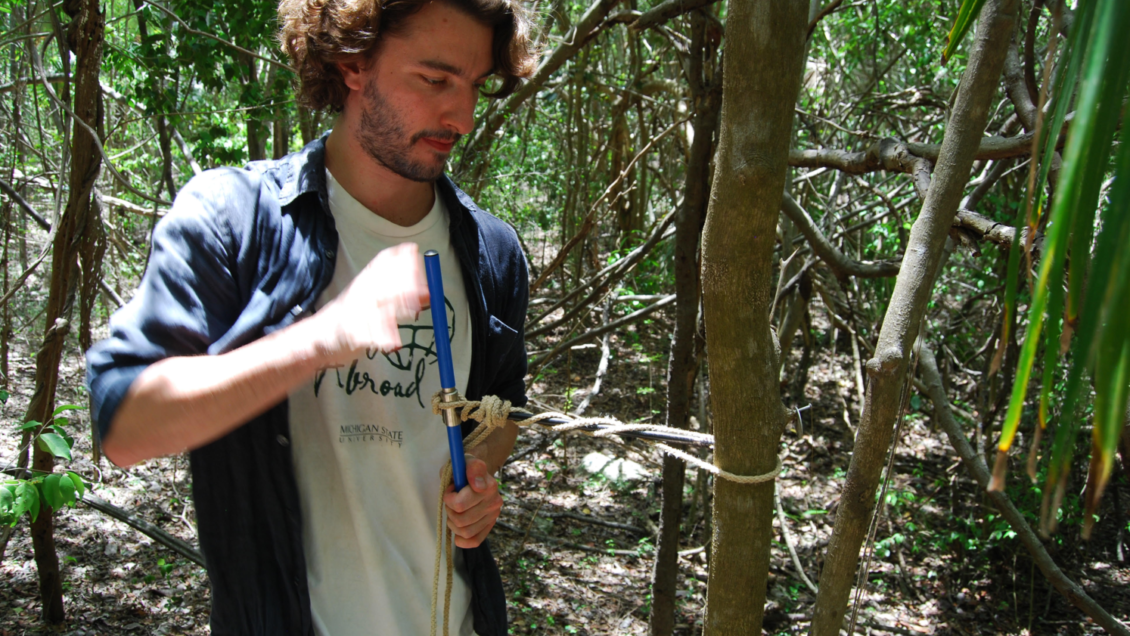
Tristan Allerton, a forest resources doctoral student at Clemson University, was recently awarded one of 23 Clemson University Doctoral Dissertation Completion Grants for 2018-2019.
More than $150,000 has been awarded to doctoral students producing high-quality scholarship on diverse topics. Allerton’s grant will go towards his research that aims to better understand how human and natural disturbance events impact dry forest water use, nutrient cycling, growth, and survival and the ways in which to use that information to better restore these threatened environments.
“I work in tropical dry forests,” said Allerton. “These forests are a lot like tropical rain forests in that they are biodiverse and warm year-round. However, dry forests distinguish themselves by the significant period each year whereby little to no rainfall occurs, often for up to six months. Forest processes therefore are overwhelmingly regulated by these seasonal droughts, and as a result, plants and animals here have evolved many unique adaptations in order to survive. The extent of these forests is global, where they can be found throughout the drier tropics on almost every continent across Latin America, Africa, the Indian sub-continent and the northern edges of Australia.”
Tropical dry forests are one of the most endangered ecosystems worldwide due to their more favorable climate and fertile soils for agriculture. Studies have shown these forests to be susceptible to destruction from human-set fires and clearing. Natural regeneration is challenging due to the stressful environmental conditions these disturbances create, such as higher temperatures, drier conditions and highly unpredictable soil moisture content.
“It would be a great tragedy if tropical dry forests disappeared, as the breathtaking biodiversity they hold is something few ecosystems can match,” Allerton said. “In terms of research and conservation, tropical dry forests have historically been overlooked relative to the more mystical and charismatic tropical rain forests. However, many of the plant species are found nowhere else on the planet, particularly in isolated regions such as on the islands of the Caribbean or in the mountains of Latin America. Molecular research has discovered incredibly ancient species sometimes millions of years old. I’ve heard these forests referred to as ‘museums of diversity,’ and I love the image that creates of their importance from a natural history perspective. We would lose a lot if these forests disappeared.”
Allerton’s research attempts to break down the characteristics that enable certain dry forest tree species to perform better in degraded locations in order to help create management practices needed for other later-successional species to return.
“The harsh environmental conditions present in degraded areas act as a filter preventing most native tree species from re-establishing,” said Allerton. “Most tree species have growth rates so low that it’s impossible for them to compete with quicker growing invasive grasses that thrive in these harsh post-fire environments. During the long dry season, these grasses burn exceptionally well and can encroach into the forest promoting further grass invasion and fire. This positive feedback loop is called the ‘grass-fire cycle,’ and it has become a threat to ecosystems globally due to the spread of invasive grasses that act as perfect fuel to promote recurring wildfires.”
When Hurricane Maria hit Puerto Rico in September last year, Allerton had the opportunity to study how hurricane events affect dry forests as well.
“Hurricanes will likely increase both in number and intensity due to climate change,” said Allerton. “When Hurricane Maria crossed the island, it caused significant damage to tree canopies stripping trees bare of their leaves and consequently disrupting their ability to collect resources. We’re trying to understand whether certain tree species are capable of compensating for this disruption by increasing resource acquisition in newly produced leaves. Such an adaptation would be further evidence of how dry forests are resilient to hurricanes and may be capable of tolerating changes in climate.
Skip Van Bloem, director of Clemson’s Baruch Institute of Coastal Ecology and Forest Science in Georgetown, S.C., is Allerton’s advisor.
“Tristan succeeds in his graduate studies because he is creative and motivated, also, because he is able to slog through the tedious parts of research with good humor, like getting up at 4 a.m. to measure pre-dawn leaf physiology before the rising sun kickstarts photosynthesis,” Van Bloem said.
“As hurricane and drought frequencies increase due to climate change, Allerton’s research will help determine sustainable ways to manage tropical forests and predict how they will react under future climates,” Van Bloem added.
Allerton has been based at the Baruch Institute since 2015. Allerton spent his previous two years as a partnership manager with a major United Kingdom-based non-governmental organization. His future plans include conservation research in the NGO sector.
“It makes sense to combine my scientific background with my previous experience building funding partnerships with government agencies and stakeholders. That said, I’m a believer one should stay open to all opportunities,” said Allerton.
Get in touch and we will connect you with the author or another expert.
Or email us at news@clemson.edu

